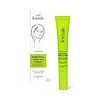What's inside
What's inside
 Key Ingredients
Key Ingredients

 Benefits
Benefits

 Concerns
Concerns

 Ingredients Side-by-side
Ingredients Side-by-side

Water
Skin ConditioningCaprylic/Capric Triglyceride
MaskingCetearyl Alcohol
EmollientCetearyl Glucoside
EmulsifyingDiethylamino Hydroxybenzoyl Hexyl Benzoate
UV FilterDimethicone
EmollientCeteareth-20
CleansingNiacinamide
SmoothingPropanediol
SolventGlyceryl Stearate
EmollientPEG-100 Stearate
Titanium Dioxide
Cosmetic ColorantMica
Cosmetic ColorantTin Oxide
AbrasiveSilica
AbrasivePhenoxyethanol
PreservativeSodium Hyaluronate
Humectant3-O-Ethyl Ascorbic Acid
Skin ConditioningSqualane
EmollientTocopherol
AntioxidantPanthenol
Skin ConditioningCaffeine
Skin ConditioningMaltodextrin
AbsorbentXanthan Gum
EmulsifyingHydroxyethylcellulose
Emulsion StabilisingPolymethylsilsesquioxane
Acrylates/C10-30 Alkyl Acrylate Crosspolymer
Emulsion StabilisingEthylhexylglycerin
Skin ConditioningOctenidine Hcl
AntimicrobialSodium Phytate
Simethicone
EmollientAminomethyl Propanol
BufferingWater, Caprylic/Capric Triglyceride, Cetearyl Alcohol, Cetearyl Glucoside, Diethylamino Hydroxybenzoyl Hexyl Benzoate, Dimethicone, Ceteareth-20, Niacinamide, Propanediol, Glyceryl Stearate, PEG-100 Stearate, Titanium Dioxide, Mica, Tin Oxide, Silica, Phenoxyethanol, Sodium Hyaluronate, 3-O-Ethyl Ascorbic Acid, Squalane, Tocopherol, Panthenol, Caffeine, Maltodextrin, Xanthan Gum, Hydroxyethylcellulose, Polymethylsilsesquioxane, Acrylates/C10-30 Alkyl Acrylate Crosspolymer, Ethylhexylglycerin, Octenidine Hcl, Sodium Phytate, Simethicone, Aminomethyl Propanol
Propanediol
SolventCetearyl Nonanoate
EmollientCetearyl Alcohol
EmollientDicetyl Phosphate
EmulsifyingCeteth-10 Phosphate
CleansingBellis Perennis Flower Extract
Skin ConditioningHieracium Pilosella Extract
MaskingNeopentyl Glycol Diheptanoate
EmollientCaprylic/Capric Triglyceride
MaskingXylitylglucoside
HumectantAnhydroxylitol
HumectantXylitol
HumectantGlycerin
HumectantWater
Skin ConditioningButylene Glycol
HumectantCarbomer
Emulsion StabilisingPolysorbate 20
EmulsifyingPalmitoyl Tripeptide-1
Skin ConditioningPalmitoyl Tetrapeptide-7
Skin ConditioningSodium Benzoate
MaskingGlyceryl Stearate
EmollientCucumis Sativus Fruit Extract
EmollientAcrylates/C10-30 Alkyl Acrylate Crosspolymer
Emulsion StabilisingTromethamine
BufferingPotassium Sorbate
PreservativePropanediol, Cetearyl Nonanoate, Cetearyl Alcohol, Dicetyl Phosphate, Ceteth-10 Phosphate, Bellis Perennis Flower Extract, Hieracium Pilosella Extract, Neopentyl Glycol Diheptanoate, Caprylic/Capric Triglyceride, Xylitylglucoside, Anhydroxylitol, Xylitol, Glycerin, Water, Butylene Glycol, Carbomer, Polysorbate 20, Palmitoyl Tripeptide-1, Palmitoyl Tetrapeptide-7, Sodium Benzoate, Glyceryl Stearate, Cucumis Sativus Fruit Extract, Acrylates/C10-30 Alkyl Acrylate Crosspolymer, Tromethamine, Potassium Sorbate
Ingredients Explained
These ingredients are found in both products.
Ingredients higher up in an ingredient list are typically present in a larger amount.
Acrylates/C10-30 Alkyl Acrylate Crosspolymer is a synthetic polymer. It is used to thicken and improve the texture of products. Due to its properties, it can prevent water and oil ingredients from separating.
This ingredient is an emollient, solvent, and texture enhancer. It is considered a skin-softener by helping the skin prevent moisture loss.
It helps thicken a product's formula and makes it easier to spread by dissolving clumping compounds.
Caprylic Triglyceride is made by combining glycerin with coconut oil, forming a clear liquid.
While there is an assumption Caprylic Triglyceride can clog pores due to it being derived from coconut oil, there is no research supporting this.
Learn more about Caprylic/Capric TriglycerideCetearyl alcohol is a mixture of two fatty alcohols: cetyl alcohol and stearyl alcohol. It is mainly used as an emulsifier. Emulsifiers help prevent the separation of oils and products. Due to its composition, it can also be used to thicken a product or help create foam.
Cetearyl alcohol is an emollient. Emollients help soothe and hydrate the skin by trapping moisture.
Studies show Cetearyl alcohol is non-toxic and non-irritating. The FDA allows products labeled "alcohol-free" to have fatty alcohols.
This ingredient is usually derived from plant oils such as palm, vegetable, or coconut oils. There is debate on whether this ingredient will cause acne.
Due to the fatty acid base, this ingredient may not be Malassezia folliculitis safe.
Learn more about Cetearyl AlcoholGlyceryl Stearate is a mix of glycerin and stearic acid.
It is used to stabilize the mixing of water and oil ingredients. By preventing these ingredients from separating, it can help elongate shelf life. It can also help thicken the product's texture.
As an emollient, it helps soften skin and supports barrier-replenishing ingredients.
In cosmetics, Glyceryl Stearate is often made from vegetable oils or synthetically produced.
This ingredient may not be fungal-acne safe
Fun fact: The human body also creates Glyceryl Stearate naturally.
Learn more about Glyceryl StearatePropanediol is an all-star ingredient. It softens, hydrates, and smooths the skin.
It’s often used to:
Propanediol is not likely to cause sensitivity and considered safe to use. It is derived from corn or petroleum with a clear color and no scent.
Learn more about PropanediolWater. It's the most common cosmetic ingredient of all. You'll usually see it at the top of ingredient lists, meaning that it makes up the largest part of the product.
So why is it so popular? Water most often acts as a solvent - this means that it helps dissolve other ingredients into the formulation.
You'll also recognize water as that liquid we all need to stay alive. If you see this, drink a glass of water. Stay hydrated!
Learn more about Water